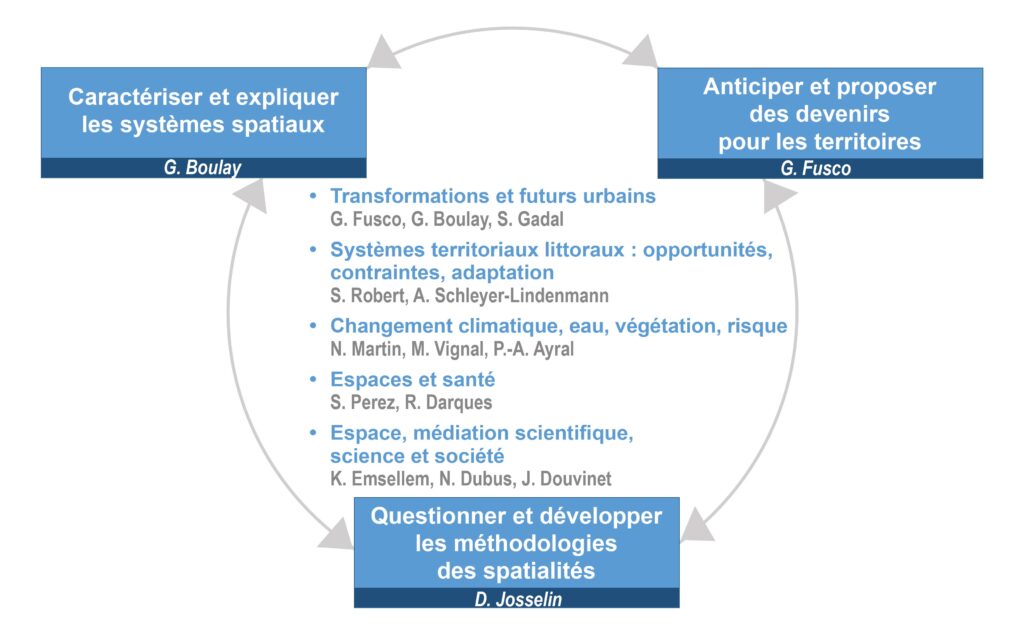UMR 7300 ESPACE - Study of Structures, Adaptation Processes and Changes in Space
Activities

Created in 1997, the ESPACE laboratory (Étude des Structures et des Processus d'Adaptation et des Changements de l'Espace) is a joint research unit (UMR 7300) which brings together three universities in the Provence-Alpes-Côte-d'Azur region with the CNRS: Avignon University, Aix-Marseille University and Université Côte d'Azur. In addition to these three main sites, there is a 'workshop zone' at Saint-Christol-lès-Alès in the Cévennes, where hydro-meteorological measurements have been carried out for over 30 years, particularly on water resources.
The laboratory has 46 permanent members, including 32 researchers - teacher-researchers, and 14 PARs (research support staff: IT and BIATSS). It also has an average of just over thirty PhD students and around fifteen contract staff (ATER, CDD, post-docs).
While the majority of team members are geographers, the unit also includes psychologists, sociologists, economists and computer scientists.
The ESPACE laboratory mainly studies space-nature-society interactions and their sustainability, from the scale of housing to that of the continent, with the Mediterranean basin as a privileged but not exhaustive field of study. ESPACE is attached to two CNRS institutes: INSHS (Institut Sciences Humaines et Sociales) and INEE (Institut Écologie et Environnement).
The main themes studied are :
- the city: its morphologies, its transport-urban planning interactions, its land and property markets, its development models and their sustainability, etc.
- the environment, in particular the impact of climate change on natural resources (water and vegetation) and on risks and risk management
- coastal territorial systems in the Mediterranean, focusing on the specific features of their coastal nature and its externalities
- interactions between space, the environment and health
Whatever the theme, ESPACE's research is distinguished by the importance it attaches to the development of spatial analysis tools and methods (in particular to deal with the multiscalar structuring of territories), modelling, whether quantitative based on simulation models or qualitative, and theorising.
Lastly, they are characterised by their strong interactions with local players (local authorities, businesses, associations, etc.) and their operational spin-offs, which ESPACE aims to amplify still further by working specifically on the players and the conditions for producing, transmitting and appropriating the knowledge generated by local sciences.
On the Internet https://www.umrespace.org
ORGANISATION
Trustees of the UMR
- CNRS
- Avignon University (AU)
- Aix Marseille University (AMU)
- Université Côte d'Azur (UCA)
Direction
Cyrille Genre-Grandpierre (Professor, AU)
Courses offered
- MASTER in Human and Social Sciences - Geography, GEOTER: GEOmatics and Territorial Project Management [UAPV].
- MASTER Geography, Planning, Environment and Development [AMU].
Geomatics and Spatial Modelling (GMS) course
or
Pathway: Coastal Management and vulnerabilities (COAST) - MASTER GEOPRAD Geoprospecting, planning and sustainability of territories [UNS].
Track: Geoprospecting, Regional Planning and Sustainability (GEOPRAD)
Research activities
Research centres
- Characterise and explain spatial systems
- Anticipating and proposing futures for territories
- Questioning and developing spatial methodologies
Research areas
- Urban transformations and futures
- Coastal territorial systems: opportunities, constraints, adaptation
- Climate change, water, vegetation, risks
- Space and Health
- Space, scientific mediation, science and society

Partnerships
National partners (some examples)
École de Mines d'Alès et de Sophia Antipolis, DRIIHM and OT-MED labex, OHM Littoral méditerranéen, Zone Atelier Basse Vallée du Rhône (ZABR), FR ECOREV, FR Agorantic, IRSTEA, LIA, I3S, LET, LISA, LTHE, GREQAM, etc.
International partners (some examples)
EIFER research centre in Karlsruhe (Germany), DIAP (Milan Polytechnic), DESTEC (University of Pisa), LISER (Luxembourg Institute of Socio-Economic Research), EPFL (Lausanne), University of Dakar, University of Tasmania, etc.
Socio-economic partners, associations
- Public institutions, consular chambers, State services: PUCA, DATAR, SCHAPI, DDT84, CCI 84, Vaucluse Chamber of Agriculture, Vaucluse Prefecture, Grand Port Maritime de Marseille, EPF-PACA
- Local authorities, EPCIs, semi-public companies: Grand Avignon, town halls (Avignon, Monteux, Montfavet, etc.), CG 84, CR PACA, COVE, mixed syndicates.
- Development associations, agencies managing the territory: Agence d'Urbanisme Rhône Avignon Vaucluse (AURAV), ARPE PACA, Plan Bleu, Natural Parks (Luberon, Alpilles, Camargue...), Pôle Numérique Drôme, AB-Cèze.
- Companies and consultancies: Transdev Group, Société du Canal de Provence, GeographR, Immochan (Auchan), Territoires et Paysages (84), Energie Géomatique (63)...
- Europe and ERDF funds (example: CORESTART project)
Further information
Competencies
- Databases and Geographic Information Systems, geomatics
- Remote sensing and image segmentation (including high resolution)
- Statistical processing of qualitative and quantitative geographical data
- Mapping, geo-visualisation, webmapping
- Territorial diagnosis in various strategic areas
- Analysis and optimisation of spatial structures
- Modelling and simulation of spatial phenomena
- Experienced practice of interdisciplinarity
Contacts
Address
Hannah Arendt Campus, Sainte Marthe site
North Building - 1E29
74 rue Louis Pasteur, 84000 Avignon
Telephone
+33 (0)4 90 16 26 98
E-mails
Keywords
Spatial analysis / Geomatics / Modelling / Urban planning / Socio-environmental challenges / Environment / Risk / Networking / Mobility / Real estate
Document to download
French/English version of the fact sheet in PDF
Mis à jour le 22 April 2024